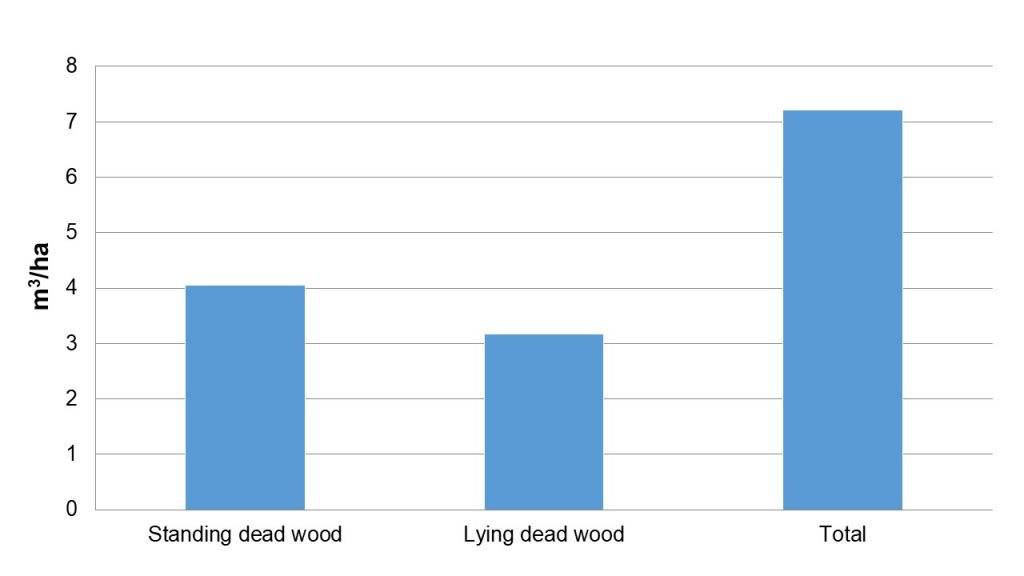Key message: The total amount of dead trees in the forests of Serbia 16,260,414 m3
Assessment: The indicator shows the amount (volume) of the upright and prostrate dead wood in the forests, which are important habitats for a large number of species. Larger quantities of such wood in the forest caused greater biodiversity of forest habitats, because it is a very important substrate component for many species. The quantity of dead wood ensures the continuity and sustainability of habitats (biotopes), especially for ornithofauna and entomofauna that live in the forests, whose habitat is sometimes limited to small parts of dead wood of specific type. Dead wood in the forests is important as habitats for a large number of species, especially upright and prostrate dead wood. Larger quantities of such wood in the forest caused greater biodiversity of forest habitats, because it is a very important substrate component for many species. Quantity of dead wood is calculated by the analysis and assessment of the number and volume of the standing and lying dead wood in the forest, with a minimum length of 2 m and trunk diameter of 10 cm per hectare of forest, and their timber mass expressed in a cubic meters per hectare (m3/ha), respectively in tons per hectare (t/ha), for a five-year period.
According to data from the Forest Inventory, total volume of dead wood in the forests of the Republic of Serbia is 16,260,414 m3. Average standing dead wood volume is 4.05 m3/ha, and lying dead woods volume is 3.17 m3/ha. In other words, total concentration of dead wood in our forests is 7.22 m3/ha, in central Serbia 7.18 m3/ha, and in Vojvodina 7.75 m3/ha, which is considerably above the norm of 2-3 m3/ha. This quantity of dead wood ensures the continuity and sustainability of habitats (biotopes), especially for ornithofauna and entomofauna that live in our forests, whose habitat is sometimes limited to small parts of dead wood of specific type. At the same time, dumping of a part of yield in the forest is a significant renewable resource in the context of conservation of the production potential of the entire habitat.

Indicator Name: Dead wood in forests
Institution/Author: Environmental Protection Agency/Slaviša Popović
Use and interpretation:
The indicator shows the amount (volume) of the upright and prostrate dead wood in the forests, which are important habitats for a large number of species. Larger quantities of such wood in the forest caused greater biodiversity of forest habitats because it is very important substrate component for many species. The quantity of dead wood ensures the continuity and sustainability of habitats (biotopes), especially for ornithofauna and entomofauna that live in the forests and whose habitat is sometimes limited to small parts of dead wood of specific type. At the same time, dumping of a part of yield in the forest is a significant renewable resource in the context of conservation of the production potential of the entire habitat.
Key question(s) which indicator helps to answer
The indicator helps to answer following questions: What is the volume of dead wood in the forest? What are volumes of standing dead wood and lying dead wood in the forests?
Use of indicator
The indicator is used to monitor state of forests in terms of sustainable forest management.
Scale of appropriate use
The indicator was prepared by the analysis and assessment of the number and volume of the standing and lying dead wood in the forest, with a minimum length of 2 m and trunk diameter of 10 cm per hectares of forest, and their timber mass expressed in a cubic meters per hectare (m3 / ha), respectively in tonnes per hectare (t / ha), for a five year period.
Potential for aggregation:
Meaning of upward or downward trends („good or bad“)
According to the data of the Forest Inventory, the total volume of dead wood in the forests of the Republic of Serbia is 16,260,414 m3. Average standing dead wood volume is 4.05 m3/ha, and lying dead woods volume is 3.17 m3/ha, in other words, the total concentration of dead wood in Serbian forests is 7.22 m3/ha, in central Serbia it is 7.18 m3/ha, and in Vojvodina 7.75 m3/ha, which is considerably above the norm of 2-3 m3/ha.
Possible reasons for upward or downward trends:
The indicator is determined for five years, and total quantity of dead wood depends on the volume of standing dead wood and lying dead wood per hectare (ha);
Implications for biodiversity management of change in the indicator:
The indicator is traditionally described in annual state of the environment reports in Serbia, and it is determined as biodiversity indicator, according to the Rulebook on the National list of environmental protection indicators (Official Gazette of the Republic of Serbia No. 37/2011).
Units in which it is expressed:
The total weight or volume of dead wood in cubic meters per hectare (m3 / ha) or in tonnes per hectare (t / ha).
Description of source data:
Forest Inventory in the Republic of Serbia, Forest Directorate
Calculation procedure:
– The surface of forest by stands in hectares (ha);
– Number and volume of standing dead wood in cubic meters (m3);
– Number and volume of the lying dead wood in cubic meters (m3);
Most effective forms of presentation:
(graph types, maps, narratives, etc.-give examples where possible):
The best ways to present this indicator are tables and graphs as they provide opportunity to monitor progress regarding this indicator and to record trends observed.
Limits to usefulness and accuracy:
(e.g. slow change in response to pressures, poor quality data, limited scope for updating)
Updating the indicator:
Data are updated in five years period.
Closely related indicators
Additional information and comments
Table: Dead wood in forests
| m3/ha | |
| Standing dead wood | 4,05 |
| Lying dead wood | 3,17 |
| Total | 7,22 |
Serbia